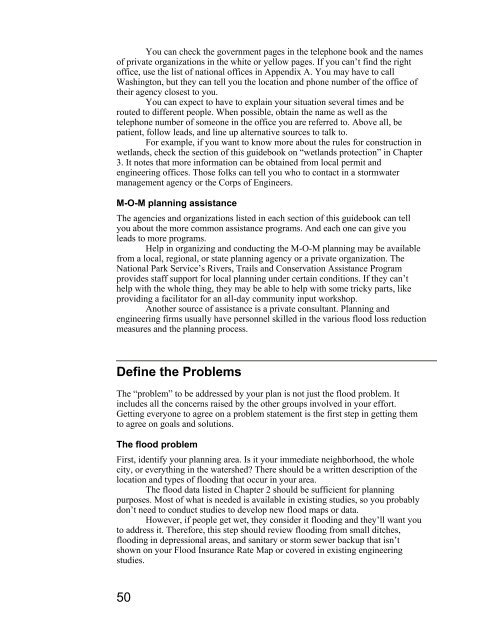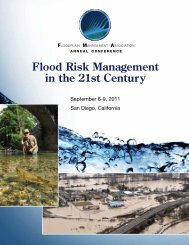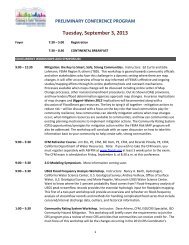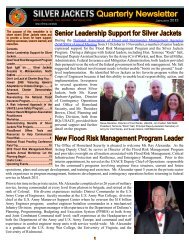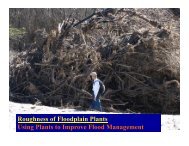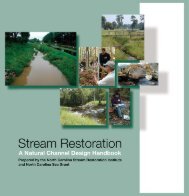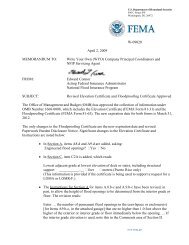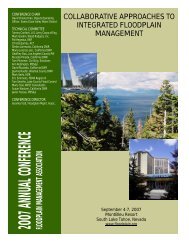Using Multi-Objective Management to Reduce Flood Losses in Your
Using Multi-Objective Management to Reduce Flood Losses in Your
Using Multi-Objective Management to Reduce Flood Losses in Your
You also want an ePaper? Increase the reach of your titles
YUMPU automatically turns print PDFs into web optimized ePapers that Google loves.
You can check the government pages <strong>in</strong> the telephone book and the names<br />
of private organizations <strong>in</strong> the white or yellow pages. If you can’t f<strong>in</strong>d the right<br />
office, use the list of national offices <strong>in</strong> Appendix A. You may have <strong>to</strong> call<br />
Wash<strong>in</strong>g<strong>to</strong>n, but they can tell you the location and phone number of the office of<br />
their agency closest <strong>to</strong> you.<br />
You can expect <strong>to</strong> have <strong>to</strong> expla<strong>in</strong> your situation several times and be<br />
routed <strong>to</strong> different people. When possible, obta<strong>in</strong> the name as well as the<br />
telephone number of someone <strong>in</strong> the office you are referred <strong>to</strong>. Above all, be<br />
patient, follow leads, and l<strong>in</strong>e up alternative sources <strong>to</strong> talk <strong>to</strong>.<br />
For example, if you want <strong>to</strong> know more about the rules for construction <strong>in</strong><br />
wetlands, check the section of this guidebook on “wetlands protection” <strong>in</strong> Chapter<br />
3. It notes that more <strong>in</strong>formation can be obta<strong>in</strong>ed from local permit and<br />
eng<strong>in</strong>eer<strong>in</strong>g offices. Those folks can tell you who <strong>to</strong> contact <strong>in</strong> a s<strong>to</strong>rmwater<br />
management agency or the Corps of Eng<strong>in</strong>eers.<br />
M-O-M plann<strong>in</strong>g assistance<br />
The agencies and organizations listed <strong>in</strong> each section of this guidebook can tell<br />
you about the more common assistance programs. And each one can give you<br />
leads <strong>to</strong> more programs.<br />
Help <strong>in</strong> organiz<strong>in</strong>g and conduct<strong>in</strong>g the M-O-M plann<strong>in</strong>g may be available<br />
from a local, regional, or state plann<strong>in</strong>g agency or a private organization. The<br />
National Park Service’s Rivers, Trails and Conservation Assistance Program<br />
provides staff support for local plann<strong>in</strong>g under certa<strong>in</strong> conditions. If they can’t<br />
help with the whole th<strong>in</strong>g, they may be able <strong>to</strong> help with some tricky parts, like<br />
provid<strong>in</strong>g a facilita<strong>to</strong>r for an all-day community <strong>in</strong>put workshop.<br />
Another source of assistance is a private consultant. Plann<strong>in</strong>g and<br />
eng<strong>in</strong>eer<strong>in</strong>g firms usually have personnel skilled <strong>in</strong> the various flood loss reduction<br />
measures and the plann<strong>in</strong>g process.<br />
Def<strong>in</strong>e the Problems<br />
The “problem” <strong>to</strong> be addressed by your plan is not just the flood problem. It<br />
<strong>in</strong>cludes all the concerns raised by the other groups <strong>in</strong>volved <strong>in</strong> your effort.<br />
Gett<strong>in</strong>g everyone <strong>to</strong> agree on a problem statement is the first step <strong>in</strong> gett<strong>in</strong>g them<br />
<strong>to</strong> agree on goals and solutions.<br />
The flood problem<br />
First, identify your plann<strong>in</strong>g area. Is it your immediate neighborhood, the whole<br />
city, or everyth<strong>in</strong>g <strong>in</strong> the watershed There should be a written description of the<br />
location and types of flood<strong>in</strong>g that occur <strong>in</strong> your area.<br />
The flood data listed <strong>in</strong> Chapter 2 should be sufficient for plann<strong>in</strong>g<br />
purposes. Most of what is needed is available <strong>in</strong> exist<strong>in</strong>g studies, so you probably<br />
don’t need <strong>to</strong> conduct studies <strong>to</strong> develop new flood maps or data.<br />
However, if people get wet, they consider it flood<strong>in</strong>g and they’ll want you<br />
<strong>to</strong> address it. Therefore, this step should review flood<strong>in</strong>g from small ditches,<br />
flood<strong>in</strong>g <strong>in</strong> depressional areas, and sanitary or s<strong>to</strong>rm sewer backup that isn’t<br />
shown on your <strong>Flood</strong> Insurance Rate Map or covered <strong>in</strong> exist<strong>in</strong>g eng<strong>in</strong>eer<strong>in</strong>g<br />
studies.<br />
50


